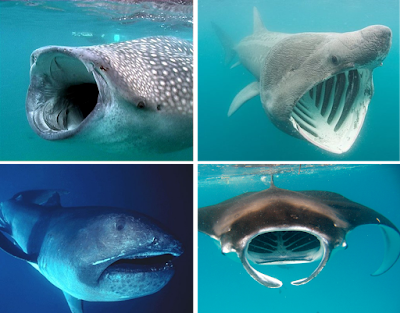 |
| FIGURE 7. Stratigraphic distributions of elasmobranch families that contain planktivorous forms and highlighting Johnlongia and Pseudomegachasma, gen. nov., as well as Megachasma applegatei and M. pelagios to show parallel evolution and convergence of ‘megachasmid tooth pattern’ from ‘odontaspidid tooth pattern’ in each clade (*, excludes other odontaspidid taxa outside of this particular clade, i.e., Johnlonginae, subfam. nov.; stratigraphic data based on Friedman et al., 2010:fig. 3; Cappetta, 2012; Shimada et al., 2014). Sources of illustrated teeth (left, labial view; right, profile view; not to scale): Johnlongia (SSU 155/93 in this study; cf. Fig. 2 A, C); Pseudomegachasma , gen. nov. (Shimada, 2007:fig. 1B, C; see also Fig. 4A, E in this study); Megachasma applegatei (Shimada et al., 2014:fig. 3B, C); and M. pelagios (Taylor et al., 1983:fig. 8A, C).
Shimada, Popov, Siversson, Welton & Long, 2015
DOI: 10.1080/02724634.2015.981335 |
ABSTRACT
Eorhincodon casei from Russia and Megachasma comanchensis from the United States are two Cretaceous taxa initially described as putative planktivorous elasmobranchs, but the type specimens of these two taxa were subsequently reinterpreted to represent taphonomically abraded teeth of an odontaspidid, Johnlongia Siverson (Lamniformes: Odontaspididae). Here, we redescribe the type materials of ‘E. casei’ and ‘M. comanchensis’ and describe additional specimens of these species from other Late Cretaceous localities in Russia and the United States. These specimens demonstrate that (1) the two fossil taxa are valid species; (2) they warrant the establishment of a new genus of presumed planktivorous sharks, Pseudomegachasma, gen. nov., to accommodate the two species; and (3) the new genus is sister to Johnlongia and together constitute a new subfamily Johnlonginae, subfam. nov., tentatively placed in the family Odontaspididae sensu stricto. This taxonomic placement indicates that the putative planktivorous clade was derived from a presumed piscivorous form (Johnlongia), with an implication that Pseudomegachasma, gen. nov., evolved a plankton-eating habit independent of the four known planktivorous elasmobranch clades (Rhincodontidae, Megachasmidae, Cetorhinidae, and Mobulidae). It also indicates that planktivorous diets evolved independently at least three times in the order Lamniformes (i.e., Megachasmidae, Cetorhinidae, and Odontaspididae), and more significantly, Pseudomegachasma, gen. nov., would represent the oldest known plankton-feeding elasmobranch in the fossil record. The present fossil record suggests that Pseudomegachasma, gen. nov., evolved in a relatively shallow-water environment in Russia in the early Cenomanian or earlier and subsequently migrated to the North American Western Interior Seaway by the mid-Cenomanian.
Kenshu Shimada, Evgeny V. Popov, Mikael Siversson, Bruce J. Welton and Douglas J. Long. 2015. A New Clade of Putative Plankton-Feeding Sharks from the Upper Cretaceous of Russia and the United States. Journal of Vertebrate Paleontology. 35(5); e981335. DOI: 10.1080/02724634.2015.981335
ResearchGate.net/publication/281332658_A_new_clade_of_putative_plankton-feeding_sharks_from_the_Upper_Cretaceous_of_Russia_and_the_United_States

ResearchGate.net/publication/281332658_A_new_clade_of_putative_plankton-feeding_sharks_from_the_Upper_Cretaceous_of_Russia_and_the_United_States

Pseudomegachasma, a newly discovered prehistoric #shark—with a giant mouth http://grnpc.org/Ig2Fx
“False Megamouth” Shark Pioneered the Plankton-Feeding Lifestyle phenomena.nationalgeographic.com/2015/09/17/false-megamouth-shark-pioneered-the-plankton-feeding-lifestyle/
Before Giant Plankton-Feeding Sharks, there were Giant Plankton-Feeding Sharks. deepseanews.com/2015/09/before-giant-plankton-feeding-sharks-there-were-giant-plankton-feeding-sharks/ via @deepseanews
